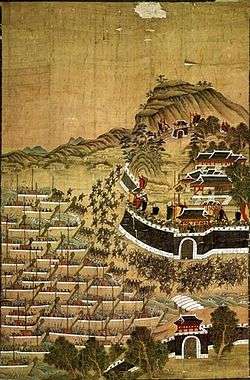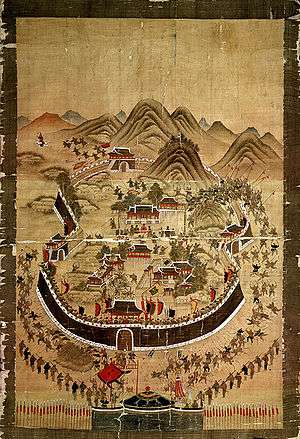Siege of Busanjin
| The Siege of Busan Castle | |||||||
|---|---|---|---|---|---|---|---|
| Part of Imjin War | |||||||
 The Siege of Busan Castle | |||||||
| |||||||
| Belligerents | |||||||
| Japanese First Division | Joseon | ||||||
| Commanders and leaders | |||||||
| Strength | |||||||
| ? | 20,000[2] | ||||||
| Casualties and losses | |||||||
| ? |
1,200-8,500 killed[3][2] 200 captured[3] | ||||||

The Siege of Busanjin was a battle fought at Busan on 24 May, 1592, between Japanese and Korean forces. The attacks on Busan and the neighboring fort of Dadaejin were the first battles of the Japanese invasions of Korea (1592–98).[4]
Background
The Japanese First Division departed from Tsushima Island on 23 May and arrived at Busan harbor without any incident. They rested there overnight and in the morning Konishi Yukinaga and Sō Yoshitoshi split their forces and attacked Busan as well as a nearby fort called Dadaejin.[5]
The Joseon fleet of 150 ships did nothing and sat idle at port while Gyeongsang Left Navy Commander Bak Hong reported to Gyeongsang Right Navy Commander Won Gyun, who thought the invasion might have been a really large trade mission.[6]
The commander of Busan, Yeong Bal, spotted the invasion fleet while hunting on Yeong Island off Busan Harbor and rushed back to Busan to prepare defenses.[5]
Battle
Early in the morning of May 24, 1592, Sō Yoshitoshi attacked Busan. They tried to take the south gate first but took heavy casualties and were forced to switch to the north gate. The Japanese took high ground positions on the mountain behind Busan and shot at Korean defenders within the city until they created a breach in their northern defenses.[2] The Koreans ran out of arrows and Commander Jeong Bal was then struck by a bullet and died, causing morale to collapse and the swift fall of the city.[4]
Aftermath
The Japanese massacred thousands. "Both men, women, and even dogs and cats were beheaded."[3] The First Division rested overnight at Busan and then advanced towards Dongnae.[7]
Gyeongsang Left Navy Commander Bak Hong watched the fall of Busan from a distance. He then scuttled his fleet of 100 ships, destroyed the weapons and provisions, and fled to Hanseong.[3]
Legacy
There is a statue of Jeong Bal next to the Japanese Consulate in Busan.[5]
See also
Citations
- ↑ Turnbull 2008, p. 10.
- 1 2 3 Swope 2009, p. 89.
- 1 2 3 4 Hawley 2005, p. 145.
- 1 2 Turnbull 2008, p. 23-24.
- 1 2 3 Turnbull 2008, p. 23.
- ↑ Hawlely 2005, p. 142.
- ↑ Turnbull 2008, p. 24.
Bibliography
- Alagappa, Muthiah (2003), Asian Security Order: Instrumental and Normative Features, Stanford University Press, ISBN 0-8047-4629-X
- Arano, Yasunori (2005), The Formation of a Japanocentric World Order, International Journal of Asian Studies
- Brown, Delmer M. (1948), "The Impact of Firearms on Japanese Warfare, 1543–1598", The Far Eastern Quarterly May 1948 (Volume 7, Number 3: pp. 236–53), Association for Asian Studies
- Eikenberry, Karl W. (1988), "The Imjin War", Military Review 68:2: 74–82
- Ha, Tae-hung; Sohn, Pow-key (1977), 'Nanjung Ilgi: War Diary of Admiral Yi Sun-sin, Yonsei University Press, ISBN 89-7141-018-3
- Haboush, JaHyun Kim (2016), The Great East Asian War and the Birth of the Korean Nation
- Hawley, Samuel (2005), The Imjin War, The Royal Asiatic Society, Korea Branch/UC Berkeley Press, ISBN 89-954424-2-5
- Jang, Pyun-soon (1998), Noon-eu-ro Bo-nen Han-gook-yauk-sa 5: Gor-yeo Si-dae (눈으로 보는 한국역사 5: 고려시대), Park Doo-ui, Bae Keum-ram, Yi Sang-mi, Kim Ho-hyun, Kim Pyung-sook, et al., Joog-ang Gyo-yook-yaun-goo-won. 1998-10-30. Seoul, Korea.
- Kim, Ki-chung (1999), "Resistance, Abduction, and Survival: The Documentary Literature of the Imjin War (1592–8)", Korean Culture 20:3 (Fall 1999): 20–29
- Kim, Yung-sik (1998), "Problems and Possibilities in the Study of the History of Korean Science", Osiris, 2nd Series, Vol. 13, Beyond Joseph Needham: Science, Technology, and Medicine in East and Southeast Asia: 48–79. JSTOR
- 桑田忠親 [Kuwata, Tadachika], ed., 舊參謀本部編纂, [Kyu Sanbo Honbu], 朝鮮の役 [Chousen no Eki] (日本の戰史 [Nihon no Senshi] Vol. 5), 1965.
- Neves, Jaime Ramalhete (1994), "The Portuguese in the Im-Jim War?", Review of Culture 18 (1994): 20–24
- Niderost, Eric (2001), "Turtleboat Destiny: The Imjin War and Yi Sun Shin", Military Heritage 2:6 (June 2001): 50–59, 89
- Niderost, Eric (2002), "The Miracle at Myongnyang, 1597", Osprey Military Journal 4:1 (January 2002): 44–50
- Park, Yune-hee (1973), Admiral Yi Sun-shin and His Turtleboat Armada: A Comprehensive Account of the Resistance of Korea to the 16th Century Japanese Invasion, Shinsaeng Press
- Rockstein, Edward D. (1993), Strategic And Operational Aspects of Japan's Invasions of Korea 1592–1598 1993-6-18, Naval War College
- Sadler, A. L., "The Naval Campaign in the Korean War of Hideyoshi (1592–1598)", Transactions of the Asiatic Society of Japan Second Series, 14 (June 1937): 179–208
- Sansom, George (1961), A History of Japan 1334–1615, Stanford University Press, ISBN 0-8047-0525-9
- Sohn, Pow-key (1959), "Early Korean Painting", Journal of American Oriental Society Vol. 79, No. 2. (April – June 1959): 96–103. JSTOR
- Stramigioli, Giuliana (1954), "Hideyoshi's Expansionist Policy on the Asiatic Mainland", Transactions of the Asiatic Society of Japan Third Series, 3 (December 1954): 74–116
- Strauss, Barry (2005), "Korea's Legendary Admiral", MHQ: The Quarterly Journal of Military History Summer 2005 (Volume 17, Number 4: 52–61
- Swope, Kenneth M. (2006), "Beyond Turtleboats: Siege Accounts from Hideyoshi's Second Invasion of Korea, 1597–1598", Sungkyun Journal of East Asian Studies (Vol. 6, No. 2. 2006 Academy of East Asian Studies.: 177–206
- Swope, Kenneth M. (2005), "Crouching Tigers, Secret Weapons: Military Technology Employed During the Sino-Japanese-Korean War, 1592–1598", The Journal of Military History: 69, 11–42. Society for Military History
- Swope, Kenneth M. (2002), "Deceit, Disguise, and Dependence: China, Japan, and the Future of the Tributary System, 1592–1596", The International History Review' XXIV. 4: December 2002: 757–1008
- Swope, Kenneth M. (2009), A Dragon's Head and a Serpent's Tail: Ming China and the First Great East Asian War, 1592–1598, University of Oklahoma Press
- Turnbull, Stephen (2002), Samurai Invasion: Japan's Korean War 1592–98, Cassell & Co, ISBN 0-304-35948-3
- Turnbull, Stephen (2008), The Samurai Invasion of Korea 1592-98, Osprey Publishing Ltd
- Turnbull, Stephen (1998), The Samurai Sourcebook, Cassell & Co, ISBN 1-85409-523-4
- Villiers, John (1980), SILK and Silver: Macau, Manila and Trade in the China Seas in the Sixteenth Century (A lecture delivered to the Hong Kong Branch of the Royal Asiatic Society at the Hong Kong Club. 10 June 1980). The HKUL Digital Initiatives External link in
|title=(help) - Yi, Min-woong (2004), Imjin Wae-ran Haejeonsa: The Naval Battles of the Imjin War [임진왜란 해전사], Chongoram Media [청어람미디어], ISBN 89-89722-49-7